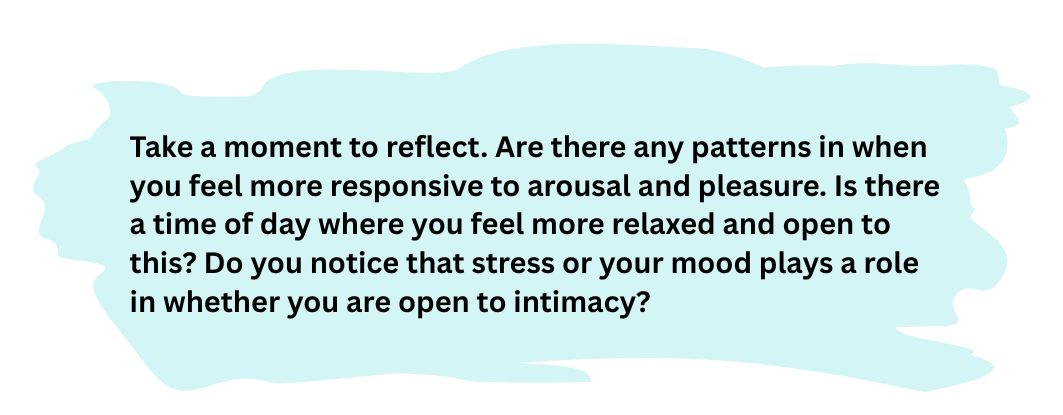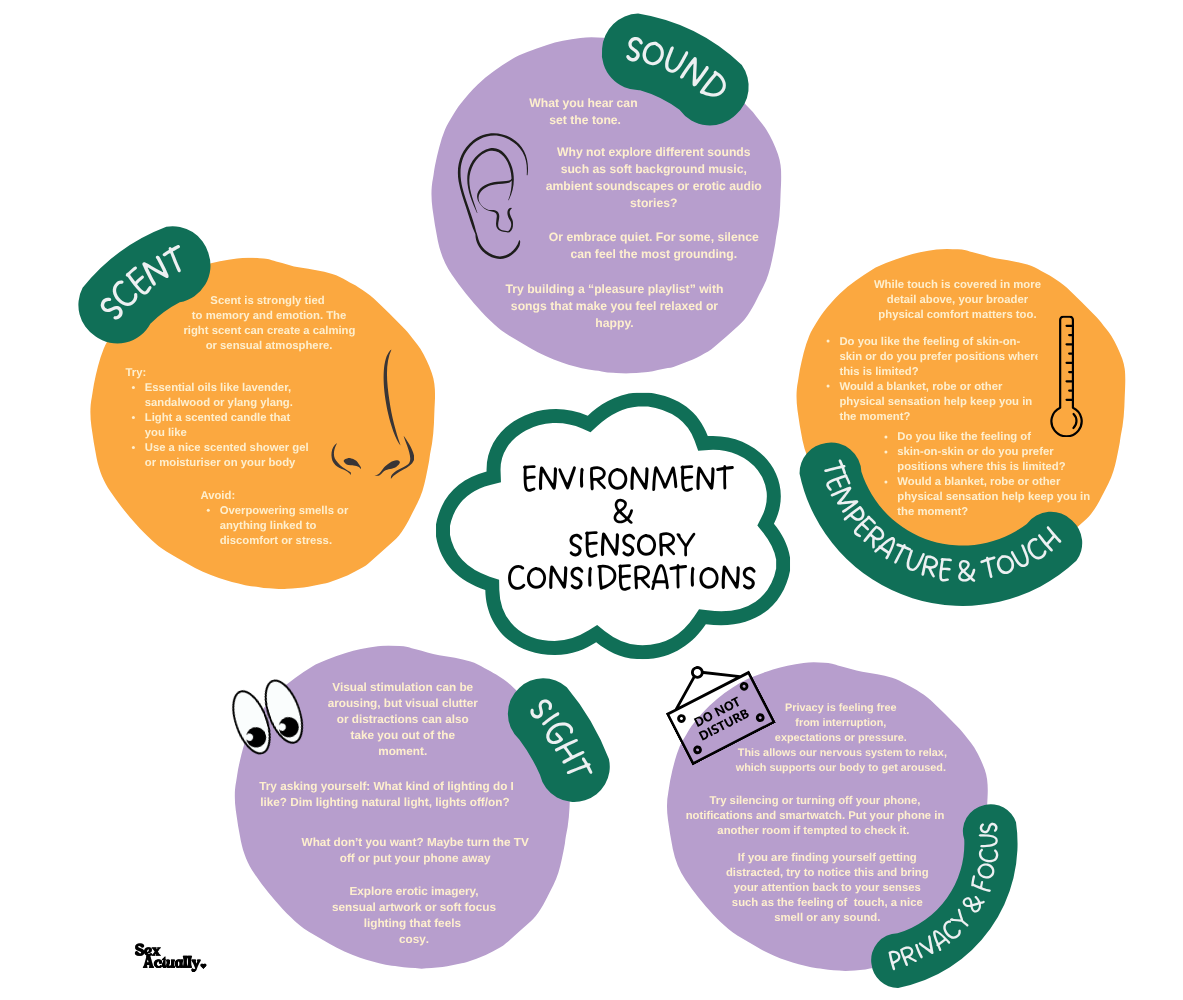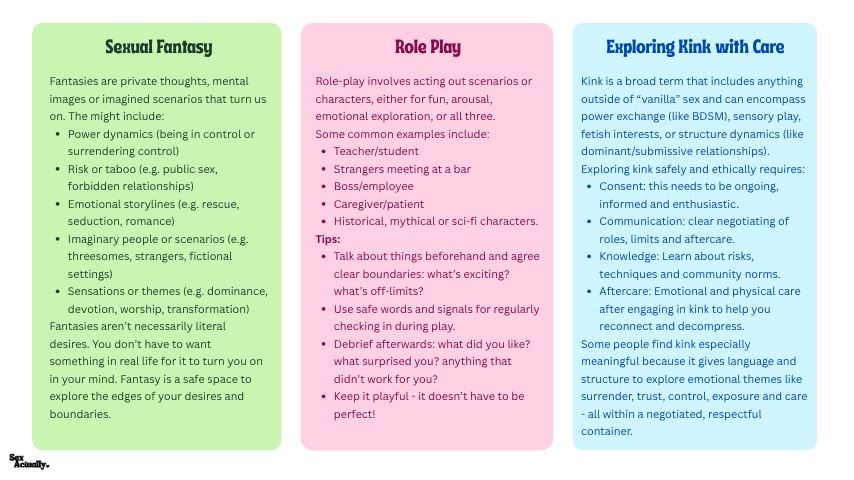Sexual pleasure is often overlooked in traditional sex education. We think it's an important topic to discuss and learn about as a natural, healthy part of human sexuality.
Understanding what brings you pleasure can help build confidence in the bedroom, deepen intimacy and make for more satisfying sexual experiences. Pleasure isn't just about sex with a partner. It starts with knowing your own body, your boundaries, your turn-on's and what feels good both physically and emotionally.
Here are some tips to get you exploring pleasure and discovering what you like:
1. Spend some time exploring your own body
It can be helpful to spend some time exploring your body without pressure or goals. We often think of self pleasure as stimulating the genitals with the aim of achieving an orgasm. Orgasms are often a source of pleasure for a lot of people, but they are not the only one, and they don't have to be the primary goal.
Pleasure can be found in many kinds of touch. This could include soft or firm touch, playful touch, stroking or circular motions. It could come from running your fingers through your hair, lightly scratching your scalp or massaging your shoulders. You might discover that the backs of your knees, your inner thighs or your belly respond in ways you didn't expect.
Try taking some time, perhaps in the shower, in bed or in front of a mirror and experiment with the following:
- Lightly run your hands over different areas of your body (e.g. arms, legs, face). As you do so, notice the temperature, texture and sensitivity of your skin.
- Experiment with different kinds of touch such as stroking, squeezing, pressing, circling.
- Try taking deep breaths as you go and stay curious. If something feels good, linger. If it doesn't, move on without judgement or self-criticism.
- Feel free to get creative, perhaps incorporate a nice scented shower gel or body oil, maybe incorporate a soft fabric or feather. Whatever feels comfortable.
The aim of exploring the body gently in this way allows you to build awareness, connection and confidence. The more you know about how your body responds to touch, the more you can communicate and express your desires, whether you are exploring pleasure solo, or with others.
Everybody has a different relationship to their own body. Being comfortable with your body is not about loving every part of it, all the time. It's about treating your body like it matters, because it does. Take your time and keep checking in with yourself.
Check out our guides for more details on self-exploration:
2. Explore what turns you on
Alongside exploring physical touch in relation to pleasure, it is also important to understand that arousal and pleasure is complex. Psychological, emotional and contextual factors all play a big role in what turns us on. Whether or not we find an experience pleasurable or not can be influenced by what is happening around us and within us, such as what we are thinking about and what emotions we are feeling.
Arousal doesn't always just happen a the click of a finger. It needs the right conditions, and those can vary. Some are essential for you to feel safe or turned on, while others might only matter sometimes, depending on your mood, the context or relationship. Gaining a good understanding of what we like and how to optimise this can help to create more satisfying experiences, whether that be solo or with others.
Here are some tips to help you explore what your turn ons are:
- Timing and Energy - when and how we get turned on can fluctuate depending on the time of day, our mood and our hormones. Some people may feel more open to intimacy and arousal in the morning, others in the evening, others in the middle of the day. Factors such as fatigue, hunger and stress can all have an influence.

- Environment & Sensory Setup - Your surroundings can have a powerful effect on your ability to relax, tune in and feel aroused. Our senses, including sight, sound, smell, touch and even temperature, all send messages to the brain that shape whether we feel safe, calm and turned on. Creating the right environment is about reducing distractions and enhancing pleasure cues that work for you.

- Visual and Erotic Stimulation - stimuli like pornography, erotic art and fantasy can be a powerful tool for triggering arousal. As noted above, using all of our senses during exploration or intimacy and pleasure can add to and compliment sexually pleasurable experiences. Examples of erotic stimulation can include watching pornography, reading erotic literature or listening to audio erotica or visualising/writing your own fantasies.
(Please note that any pornographic material that you explore should be legal and age-appropriate. While porn can be a source of arousal, it should never replace comprehensive, evidence-based sex education).
- Fantasy, Role-Play & Exploring Kink - Sexual imagination can play a big part in many peoples pleasure and identity. Fantasies, role-play and kink can provide ways to explore power, vulnerability, creativity and taboo, often in personal and liberating ways. Whether kept private or shared with others, engaging in fantasy can heighten arousal, deepen self-knowledge and offer powerful emotional or psychological experiences.

- Connection and Emotional Safety - emotional safety is one of this most important foundations for enjoyable and meaningful sex. When we feel safe, accepted and emotionally present, we are more likely to relax, stay in our bodies and open ourselves to pleasure. This applies whether you are with a trusted partner(s), exploring a new connection or simply alone and tuning into yourself. Feeling emotionally safe matters as it can reduce anxiety and pressure to 'perform'. It allows us to be more curious and playful. Some key elements of emotional safety include:
- Trust and consent. Knowing that your boundaries will be respected and that you can say no or change your mind at any point is essential for feeling safe. Clear communication before, during and after intimacy can support trust and ensure consent is always present.
- Mutual respect. If you are exploring intimacy with a partner(s), listening to each other, affirming your partner's preferences, communicating your preferences and showing care for each others wellbeing is very important. Sex and intimacy should be considerate of everyones gratification. Show understanding toward yours and your partner's emotions and allow space for vulnerability without judgement or ridicule.
- Check in with yourself. Even when you are exploring solo pleasure, emotional safety still matters. Notice if you are experiencing any negative thoughts or emotions and try not to get too drawn into them or judge yourself for having them. Your body is worthy and deserving of pleasure. Don't put pressure on yourself to "perform" a certain way or achieve an orgasm, try to notice all the factors and sensations that make intimacy pleasurable.
"It's OK to slow down or stop at any point."
"There is no pressure to feel or do anything specific."
"What helps you to feel most relaxed or connected?"
"I want you to feel safe with me, what can I do to help that feel more true?"





